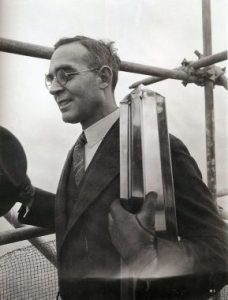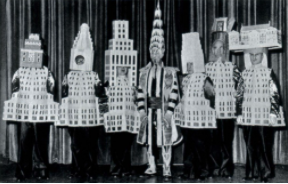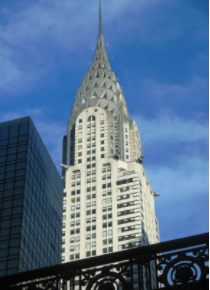American architect, William van Alen was best known as the man in charge of designing New York City’s Chrysler Building (1928–30).

Image source: https://en.wikipedia.org/wiki/William_Van_Alen#/media/File:William_Van_Alen.jpg
The price of construction
William Van Alen was born in Brooklyn, New York in 1883. He attended the Pratt Institute while working for the architect Clarence True, before studying for three years at the Atelier Masqueray, the first independent architecture studio in the United States. After concluding his formation, Van Alen worked for a number of companies in New York: in particular, the Hotel Astor for Clinton & Russell, in 1902. At the age of 25, he won the Paris Prize scholarship, considered a tremendous honor for any architect, and allowing him to continue his studies at the École des Beaux-Arts. When he returned to New York, in 1910, he became interested in new architectural styles, especially the modernist wave for which he later became known. In 1911, he formed a partnership with H. Craig Severance, another architect with similar professional interests but a very different personal style. Initially, the partnership grew, but at one point not much later their relationship had become tense (due to their aforementioned personal differences) and the firm dissolved in 1924.

Image source: https://search.creativecommons.org/photos/5a9b1851-791b-4384-9321-8620fb795134 by manhhai
In the late 1920s, Severance and Van Alen found themselves busy designing skyscraper buildings, announced by the press to become the tallest buildings in the world. However, both would be surpassed in height by the Empire State Building in 1931. The completion of the Chrysler Building was received by critics with mixed reactions. Van Alen was hailed as a “Doctor of Altitude” and the building itself was described by some critics as a mere flashy gimmick which “embodies no compelling, organic idea”. Van Alen, on his own end, had failed to enter a contract with Walter Chrysler when he received the Chrysler Building commission. After Chrysler refused the payment, Van Alen sued him and won, eventually receiving the full commission. Despite the victory, however, the whole legal proceeding had significantly tarnished his reputation as an employable architect. After his career was eventually ruined by this incident, Van Alen focused his attention on teaching sculpture. He’d teach until his death, in 1954.
The Chrysler Building
The American architect created the famous New York City’s, art-deco Chrysler Building for Walter Percy Chrysler, a well-known American automobile entrepreneur. Chrysler, in addition to commissioning the project, became an integral part of the realization of the work by inserting ten additional floors and some stylistic elements to recall the world of cars, such as the winged plugs of the radiators and the stylization of automotive wheels represented in the friezes.

Image source: https://search.creativecommons.org/photos/ba4bcd8c-86ef-47af-ba58-978a3a82b9e2 by westher
After having been home to Chrysler and privately owned by the family until 1953, today the skyscraper houses some residential apartments, offices and an entire floor dedicated to technical equipment. The building was also declared “National Historic Landmark” in 1976 and as “New York City Landmark” in 1978. The top of the skyscraper is characterized by a cusp with triangular windows and a spire, in stainless steel, about 40 meters high, mounted in great secrecy in less than two hours to be able to win the competition, born in those years, which saw opposing the work of Van Alen and the Trump Building by Severance.

Image source: https://search.creativecommons.org/photos/d79409bf-ef09-4837-b977-283f1365b391 by PortableNYCTours
To win the tallest building title in the world, Severance decides to secretly add two additional plans to the original project to overcome the work of Van Alen. Even the construction of the Chrysler Building spire was carried out in secret so that the title could therefore be given to the Chrysler Building, which, however, held the record for only a year when, in 1931, the Empire State Building surpassed it with its twenty floors, disappointing the expectations and desires of Chrysler and Van Alen alike.
How can we identify van Allen’ style?
William van Alen had an introverted personality, an eye for innovation and an attention to detail. In 1914, on a multistory commercial building, Van Alen began a push towards Modernism, a distinct shift from the Beaux-Arts style that embraced new materials and methods of construction. On this building, with a steel structure, he placed giant windows flush with a limestone wall. This may not seem like an important step, but at the time it was unheard of. He tried to eliminate the claim that buildings had large bases of stone to support the weight, even if there was a structural steel skeleton doing the work.
Info sources:
https://alchetron.com/William-Van-Alen#-
https://www.talassamagazine.com/talassa/2016/09/21/labbicci-dellarchitettura-william-van-alen
https://study.com/academy/lesson/architect-william-van-alen-chrysler-building-works-biography.html
